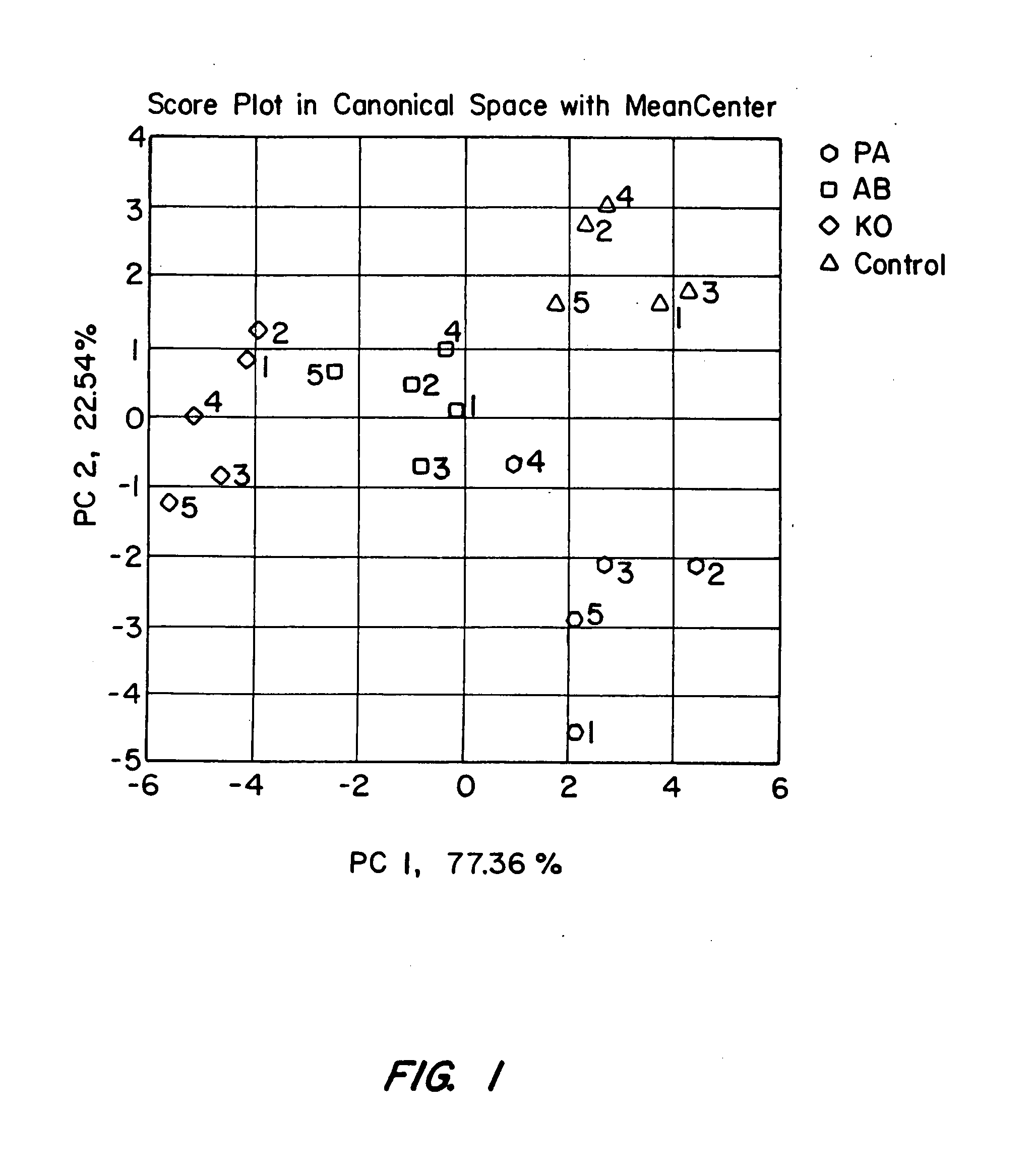Detection, diagnosis, and monitoring of a medical condition or disease with artificial olfactometry
a technology of artificial olfactometry and medical condition, which is applied in the field of detection, diagnosis and monitoring of medical condition or disease with artificial olfactometry, can solve the problems of time-consuming and multiple tests, and achieve the effect of rapid diagnosis and rapid detection of diseas
- Summary
- Abstract
- Description
- Claims
- Application Information
AI Technical Summary
Benefits of technology
Problems solved by technology
Method used
Image
Examples
example 1
[0068] This example illustrates that an electronic sensor array can be used to distinguish bacterial cultures and to distinguish infected from noninfected patients.
In Vitro Results for Upper Respiratory Bacteria: Identification of Signature Responses
[0069] This example demonstrates the use of sensor arrays in accordance with embodiments of the present invention for detection of respiratory bacterial pathogens in vitro. This set of experiments was designed to test whether very small quantities of bacteria, collected on fine swabs in vitro, can be discriminated with the electronic nose.
[0070] Specifically, the electronic nose's ability to distinguish between swabs containing bacterial cells (“positive”) and control swabs without bacterial cells (“negative”), using known plated bacteria was examined. In the first experiment, five swabs of each bacterial species were compared to five control swabbings placed in normal saline. For each of the three bacteria tested, the electronic nos...
example 2
Identification of Upper Respiratory Bacteria
[0075] This example illustrates the ability of the device used in methods of this invention to identify bacterial cultures.
[0076] Pure cultures of the most common URI pathogens (Streptococcus pneumoniae, Streptococcus pyogenes, Staphylococcus aureus, Moraxella catarrhalis, Haemophilus influenzae) were presented to the sensor array along with uninoculated medium controls. Representative results are shown in FIG. 2. The in vitro results show distinct clustering by species or genus and demonstrate that the sensor array can detect unique chemistries in the air above growing cultures. The patterns of response to these chemical differences are stored as digital “smellprints”. Training the devices on pure cultures allows for identification of unknown cultures that are presented for analysis. Over a two-week period, the device correctly identified bacteria with a 93% to 100% correct success rate after a single training session on the first day. ...
example 3
Correlation between Clinical Indicator and Sensor Results
[0077] This example illustrates that there is a close correspondence between the CPIS score for detection of ventilator-associated pneumonia and the degree of infection predicted from the sensor arrays used in methods of this invention.
[0078] Air is sampled directly from the ventilator circuit of patients and the response from the sensor array is compared to clinical indicators of infection. The combined pulmonary infection score (CPIS) incorporates patient temperature, leukocyte count, radiography and several other measures to estimate the risk for pneumonia. Data for 15 patients is shown in FIG. 6. FIG. 6 illustrates the correlation of the predicted and actual pneumonia score for the ventilator patients determined using the Cyrano medical nose prototype. The diagonal line has unit slope. Patients with medium to high score would be treated for infection while patients with low score would not. This figures shows that the pr...
PUM
| Property | Measurement | Unit |
|---|---|---|
| conductive | aaaaa | aaaaa |
| concentration | aaaaa | aaaaa |
| magnetic | aaaaa | aaaaa |
Abstract
Description
Claims
Application Information
 Login to View More
Login to View More - Generate Ideas
- Intellectual Property
- Life Sciences
- Materials
- Tech Scout
- Unparalleled Data Quality
- Higher Quality Content
- 60% Fewer Hallucinations
Browse by: Latest US Patents, China's latest patents, Technical Efficacy Thesaurus, Application Domain, Technology Topic, Popular Technical Reports.
© 2025 PatSnap. All rights reserved.Legal|Privacy policy|Modern Slavery Act Transparency Statement|Sitemap|About US| Contact US: help@patsnap.com



